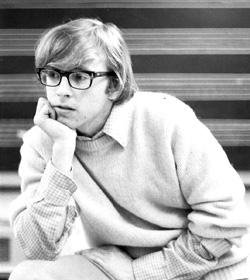Remembering Hugh
Closing the 2014 Toronto International Electroacoustic Symposium (TIES) was the Special Session “A Noisome Pestilence: An afternoon of Hugh Le Caine,” which brought together composers and researchers around Le Caine’s instruments. The session was moderated by Gayle Young on Sunday, 17 August 2014, and featured presentations by Kevin Austin, Richard Henninger, David Jaeger, Pauline Oliveros and Paul Pedersen.
In 1969, I was at the University of Wisconsin, Madison and I came across an article in The Electronic Music Review. The journal was published in Trumansburg — which happened to be a village in upstate New York where Bob Moog had started his manufacturing company — and was available through the academic periodical literature service. And in this particular edition was an article on the Serial Sound Structure Generator.
The article had been written by Professor Gustav Ciamaga and James Gabura, a PhD candidate in Computer Science at the time. It was extremely intelligently presented. I, at the age of 22, had no experience with electronic media at that point. I had been composing since I was a teenager and I had imagined that, in the future, electronic media might offer a compositional language that I would want to engage with and work with. But there I was, reading this article — it wasn’t a particularly long article, but it certainly made an impression on me. And later that year, when the Woodrow Wilson International Foundation decided to appoint me as one of their fellows, I mentioned in the documents I had to prepare for them that I had been very attracted to the University of Toronto’s electronic music studio because I had seen some of the articles written by researchers involved with this studio.

It wasn’t much longer before I became enrolled as a master’s student at the University of Toronto.
I remember, in the summer of 1970, that the thing that had impressed me most when Professor Harvey Olnick invited me to come and, as he put it, “Check us out,” was that, first of all, they had a full-time audio engineer on staff. This seemed quite remarkable, compared to where I was coming from, and where graduate students were occasionally engaged to fix things and update the studio gear. This was impressive, and the other thing was that all of Hugh Le Caine’s instruments were arrayed here, a marvellous, pristine collection. And so I did make the decision to come to Toronto the following fall.
Professor Ciamaga gave my fellow students and me a kind of crash course in all the classic studio and tape techniques, and in a matter of mere weeks, we were already producing pieces. I produced my first tape work — well, there were a few etudes first, but then as the academic calendar was winding down, it was time to produce a class project and a proper composition was expected. And so I produced something that pays a rather obvious nod to the composer of Dripsody. It’s a composition titled Bwamerail and the title was invented out of the sources of the sonic elements that were used in its creation, namely a bowl of water, a hammer and a nail (Audio 1).
That was a 23-year-old me making my first attempt at electroacoustic composition.
I must say that Hugh made a point of making himself available to the students. He wanted to know what he could do to help us work more effectively in the studio to create electronic music. This is pretty much the cornerstone memory I have of Hugh Le Caine, and it’s that he was an applied scientist. He was not a pure scientist, although he could certainly do pure science, but he always felt, as he said in a 1973 CBC Radio documentary, that “The genius of the artist is the ability to marry the science with an emotional message.” This was something that came up frequently. He saw his role as being in the service of artists.
I happen to have known, through my extended family, some people who were also from Port Arthur, people who grew up with Hugh and who described him as a most impressive young man whom people already recognized as a genius. He would astound people with the power of his mind, his imagination, his technical ability and his ability to create, even as a very young man. This particular family member asking, when we met up in Toronto, ”Oh, you’re working with Hugh Le Caine — what’s happened with him? He had such great potential!” I assured her that his potential was most certainly being realized and fulfilled. But I knew him as a friend and as a colleague, and I still fondly remember those long conversations and endless hours of explanation that he would gladly give to anyone who showed an interest in his work.
Hugh did once invite the group of students in my class in the University of Toronto studio up to Ottawa to the National Research Council (NRC) to see the lab and Ken Pulfer’s project, and he was a most gracious and accommodating host to us. And as I just said, he never hesitated to make himself available to any and all of us.
Social top